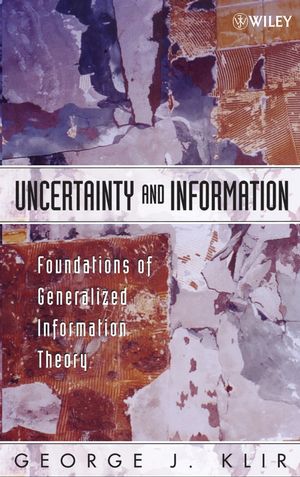Uncertainty and Information: Foundations of Generalized Information TheoryISBN: 978-0-471-74867-0
Hardcover
518 pages
November 2005, Wiley-IEEE Press
 This is a Print-on-Demand title. It will be printed specifically to fill your order. Please allow an additional 10-15 days delivery time. The book is not returnable.
|
||||||
Preface xiii
Acknowledgments xvii
1 Introduction 1
1.1. Uncertainty and Its Significance 1
1.2. Uncertainty-Based Information 6
1.3. Generalized Information Theory 7
1.4. Relevant Terminology and Notation 10
1.5. An Outline of the Book 20
Notes 22
Exercises 23
2 Classical Possibility-Based Uncertainty Theory 26
2.1. Possibility and Necessity Functions 26
2.2. Hartley Measure of Uncertainty for Finite Sets 27
2.2.1. Simple Derivation of the Hartley Measure 28
2.2.2. Uniqueness of the Hartley Measure 29
2.2.3. Basic Properties of the Hartley Measure 31
2.2.4. Examples 35
2.3. Hartley-Like Measure of Uncertainty for Infinite Sets 45
2.3.1. Definition 45
2.3.2. Required Properties 46
2.3.3. Examples 52
Notes 56
Exercises 57
3 Classical Probability-Based Uncertainty Theory 61
3.1. Probability Functions 61
3.1.1. Functions on Finite Sets 62
3.1.2. Functions on Infinite Sets 64
3.1.3. Bayes’ Theorem 66
3.2. Shannon Measure of Uncertainty for Finite Sets 67
3.2.1. Simple Derivation of the Shannon Entropy 69
3.2.2. Uniqueness of the Shannon Entropy 71
3.2.3. Basic Properties of the Shannon Entropy 77
3.2.4. Examples 83
3.3. Shannon-Like Measure of Uncertainty for Infinite Sets 91
Notes 95
Exercises 97
4 Generalized Measures and Imprecise Probabilities 101
4.1. Monotone Measures 101
4.2. Choquet Capacities 106
4.2.1. Möbius Representation 107
4.3. Imprecise Probabilities: General Principles 110
4.3.1. Lower and Upper Probabilities 112
4.3.2. Alternating Choquet Capacities 115
4.3.3. Interaction Representation 116
4.3.4. Möbius Representation 119
4.3.5. Joint and Marginal Imprecise Probabilities 121
4.3.6. Conditional Imprecise Probabilities 122
4.3.7. Noninteraction of Imprecise Probabilities 123
4.4. Arguments for Imprecise Probabilities 129
4.5. Choquet Integral 133
4.6. Unifying Features of Imprecise Probabilities 135
Notes 137
Exercises 139
5 Special Theories of Imprecise Probabilities 143
5.1. An Overview 143
5.2. Graded Possibilities 144
5.2.1. Möbius Representation 149
5.2.2. Ordering of Possibility Profiles 151
5.2.3. Joint and Marginal Possibilities 153
5.2.4. Conditional Possibilities 155
5.2.5. Possibilities on Infinite Sets 158
5.2.6. Some Interpretations of Graded Possibilities 160
5.3. Sugeno l-Measures 160
5.3.1. Möbius Representation 165
5.4. Belief and Plausibility Measures 166
5.4.1. Joint and Marginal Bodies of Evidence 169
5.4.2. Rules of Combination 170
5.4.3. Special Classes of Bodies of Evidence 174
5.5. Reachable Interval-Valued Probability Distributions 178
5.5.1. Joint and Marginal Interval-Valued Probability Distributions 183
5.6. Other Types of Monotone Measures 185
Notes 186
Exercises 190
6 Measures of Uncertainty and Information 196
6.1. General Discussion 196
6.2. Generalized Hartley Measure for Graded Possibilities 198
6.2.1. Joint and Marginal U-Uncertainties 201
6.2.2. Conditional U-Uncertainty 203
6.2.3. Axiomatic Requirements for the U-Uncertainty 205
6.2.4. U-Uncertainty for Infinite Sets 206
6.3. Generalized Hartley Measure in Dempster–Shafer Theory 209
6.3.1. Joint and Marginal Generalized Hartley Measures 209
6.3.2. Monotonicity of the Generalized Hartley Measure 211
6.3.3. Conditional Generalized Hartley Measures 213
6.4. Generalized Hartley Measure for Convex Sets of Probability Distributions 214
6.5. Generalized Shannon Measure in Dempster-Shafer Theory 216
6.6. Aggregate Uncertainty in Dempster–Shafer Theory 226
6.6.1. General Algorithm for Computing the Aggregate Uncertainty 230
6.6.2. Computing the Aggregated Uncertainty in Possibility Theory 232
6.7. Aggregate Uncertainty for Convex Sets of Probability Distributions 234
6.8. Disaggregated Total Uncertainty 238
6.9. Generalized Shannon Entropy 241
6.10. Alternative View of Disaggregated Total Uncertainty 248
6.11. Unifying Features of Uncertainty Measures 253
Notes 253
Exercises 255
7 Fuzzy Set Theory 260
7.1. An Overview 260
7.2. Basic Concepts of Standard Fuzzy Sets 262
7.3. Operations on Standard Fuzzy Sets 266
7.3.1. Complementation Operations 266
7.3.2. Intersection and Union Operations 267
7.3.3. Combinations of Basic Operations 268
7.3.4. Other Operations 269
7.4. Fuzzy Numbers and Intervals 270
7.4.1. Standard Fuzzy Arithmetic 273
7.4.2. Constrained Fuzzy Arithmetic 274
7.5. Fuzzy Relations 280
7.5.1. Projections and Cylindric Extensions 281
7.5.2. Compositions, Joins, and Inverses 284
7.6. Fuzzy Logic 286
7.6.1. Fuzzy Propositions 287
7.6.2. Approximate Reasoning 293
7.7. Fuzzy Systems 294
7.7.1. Granulation 295
7.7.2. Types of Fuzzy Systems 297
7.7.3. Defuzzification 298
7.8. Nonstandard Fuzzy Sets 299
7.9. Constructing Fuzzy Sets and Operations 303
Notes 305
Exercises 308
8 Fuzzification of Uncertainty Theories 315
8.1. Aspects of Fuzzification 315
8.2. Measures of Fuzziness 321
8.3. Fuzzy-Set Interpretation of Possibility Theory 326
8.4. Probabilities of Fuzzy Events 334
8.5. Fuzzification of Reachable Interval-Valued Probability Distributions 338
8.6. Other Fuzzification Efforts 348
Notes 350
Exercises 351
9 Methodological Issues 355
9.1. An Overview 355
9.2. Principle of Minimum Uncertainty 357
9.2.1. Simplification Problems 358
9.2.2. Conflict-Resolution Problems 364
9.3. Principle of Maximum Uncertainty 369
9.3.1. Principle of Maximum Entropy 369
9.3.2. Principle of Maximum Nonspecificity 373
9.3.3. Principle of Maximum Uncertainty in GIT 375
9.4. Principle of Requisite Generalization 383
9.5. Principle of Uncertainty Invariance 387
9.5.1. Computationally Simple Approximations 388
9.5.2. Probability–Possibility Transformations 390
9.5.3. Approximations of Belief Functions by Necessity Functions 399
9.5.4. Transformations Between l-Measures and Possibility Measures 402
9.5.5. Approximations of Graded Possibilities by Crisp Possibilities 403
Notes 408
Exercises 411
10 Conclusions 415
10.1. Summary and Assessment of Results in Generalized Information Theory 415
10.2. Main Issues of Current Interest 417
10.3. Long-Term Research Areas 418
10.4. Significance of GIT 419
Notes 421
Appendix A Uniqueness of the U-Uncertainty 425
Appendix B Uniqueness of Generalized Hartley Measure in the Dempster–Shafer Theory 430
Appendix C Correctness of Algorithm 6.1 437
Appendix D Proper Range of Generalized Shannon Entropy 442
Appendix E Maximum of GSa in Section 6.9 447
Appendix F Glossary of Key Concepts 449
Appendix G Glossary of Symbols 455
Bibliography 458
Subject Index 487
Name Index 494



